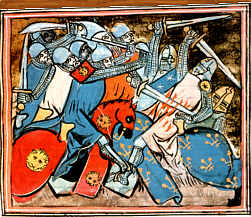Battle of Tagliacozzo
| date | August 23, 1268 |
|---|---|
| place | Tagliacozzo , Province of L'Aquila |
| output | Guelfan victory |
| Parties to the conflict | |
|---|---|
|
Ghibellines ( Staufer ) |
|
| Commander | |
|
|
|
| Troop strength | |
| 4,000 to 4,500 men | 3,500 riders |
| losses | |
|
unknown |
unknown |
The Battle of Tagliacozzo from 23. August 1268 ended the attempt of Conradin , the Kingdom of Sicily by Charles of Anjou for the Staufer recover.
prehistory
After Charles of Anjou had been enfeoffed with the Kingdom of Sicily by the Pope and his Staufer King Manfred , Conradin's uncle, had defeated and killed in the Battle of Benevento in 1266 , Konradin set out in Germany in August 1267 to regain his inheritance. While the German princes did not give him any support worth mentioning, some members of the lower nobility and Margrave Friedrich I of Baden-Austria, who had been expelled from his homeland, accompanied him . He was supported in this by the Ghibelline cities of central Italy under the leadership of Pisa and by revolts that had broken out in the Kingdom of Sicily against the harsh rule of Charles of Anjou.
Course of the battle
On August 18, 1268, Konradin left Rome with his 4,000 to 4,500-strong army, which consisted of German knights, Italian Ghibellines, but also foot troops, in order to possibly unite with the Saracens of Lucera ( Apulia ), who were fighting against Charles had rebelled from Anjou. This moved against Konradin's army with a contingent of perhaps 3,000 to 3,500 horsemen and tried to put the Staufer contingent on battle at Tagliacozzo . This attempt failed, however, because the Hohenstaufen troops evaded to the north near Carsoli and moved over Pietrasecca, Leofreni and the mountains of Abruzzo into the valley of the Salto . Upstream the army reached Magliano on the edge of the Palentine plain. There, between the places Magliano and Albe on the Palentine plain (and consequently not near Tagliacozzo), the decisive battle between Conradin, his commanders and Charles of Anjou took place on August 23rd. The disadvantage of Karl's numerical inferiority was outweighed by tactical superiority, a successfully applied stratagem and the uniformity of the supreme command. At its core, his army consisted of French knights under Érard de Valéry , some of whom had taken part in the crusades and had learned Arab tactics such as false escape. Both armies were set up in three lines of battle. Konradin was in the third row with Friedrich von Baden-Austria due to his youth and inexperience. Heinrich von Kastilien and Konradin's Marshal Konrad Kropf von Flüglingen held the actual command . Charles kept a reserve of about 1,000 French knights hidden behind hills under his leadership. The first two rows of Karl were driven away and pursued by the Hohenstaufen troops with heavy losses. Karl took the opportunity to surprisingly attack the third series of battles with Konradin with his reserve. Riders from the first two ranks of the Hohenstaufen dynasty, returning from the pursuit, intervened in the battle, but let themselves be deceived and lured away by parts of the French. After a bitter and very costly fight, which resulted in a total of about 4,000 dead, Karl kept the field. He had prisoners of the Hohenstaufen army executed on the battlefield. Although Konradin was able to flee at first, Giovanni Frangipani captured him, extradited him to Karl and executed him on October 29 in Naples .
Consequences and meaning
With the defeat of Tagliacozzo and the subsequent execution of Konradin and his followers in Naples, the Hohenstaufen dynasty finally ceded the history of Germany and Italy. At the same time it meant the ruin of the Ghibelline party and established the predominance of the French in Italy for a few years; After the battle, Charles of Anjou broke the last resistance against his rule with extreme severity and had rebels and followers of Konradin mercilessly hunted down and executed. Nevertheless, he was not able to secure permanent possession of Sicily because in 1282 there was a successful popular uprising against the French foreign rulers, the Sicilian Vespers . As a result, the Staufer heir Peter III. of Aragón win this kingdom for themselves, while Charles only remained the kingdom of Naples .
swell
- Guillaume de Nangis , Gesta Sancti Ludovici , ed. by M. Daunou in the Recueil des Historiens des Gaules et de la France (RHGF) , Vol. XX (Paris, 1840), pp. 430–437.
literature
- Peter Herd : The Battle of Tagliacozzo. In: Journal for Bavarian State History. Vol. 25 (1962), pp. 679-744 ( digitized version ).
- Hartmut Jericke: Konradin's march from Rome to the Palentine plain in August 1268. In: Roman historical messages. Vol. 44 (2002), pp. 151-190.
